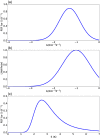An Assessment of Earth's Climate Sensitivity Using Multiple Lines of Evidence
- PMID: 33015673
- PMCID: PMC7524012
- DOI: 10.1029/2019RG000678
An Assessment of Earth's Climate Sensitivity Using Multiple Lines of Evidence
Abstract
We assess evidence relevant to Earth's equilibrium climate sensitivity per doubling of atmospheric CO2, characterized by an effective sensitivity S. This evidence includes feedback process understanding, the historical climate record, and the paleoclimate record. An S value lower than 2 K is difficult to reconcile with any of the three lines of evidence. The amount of cooling during the Last Glacial Maximum provides strong evidence against values of S greater than 4.5 K. Other lines of evidence in combination also show that this is relatively unlikely. We use a Bayesian approach to produce a probability density function (PDF) for S given all the evidence, including tests of robustness to difficult-to-quantify uncertainties and different priors. The 66% range is 2.6-3.9 K for our Baseline calculation and remains within 2.3-4.5 K under the robustness tests; corresponding 5-95% ranges are 2.3-4.7 K, bounded by 2.0-5.7 K (although such high-confidence ranges should be regarded more cautiously). This indicates a stronger constraint on S than reported in past assessments, by lifting the low end of the range. This narrowing occurs because the three lines of evidence agree and are judged to be largely independent and because of greater confidence in understanding feedback processes and in combining evidence. We identify promising avenues for further narrowing the range in S, in particular using comprehensive models and process understanding to address limitations in the traditional forcing-feedback paradigm for interpreting past changes.
Keywords: Bayesian methods; Climate; climate sensitivity; global warming.
©2020. American Geophysical Union. All Rights Reserved.
Figures
























Comment in
-
Climate impact assessments should not discount 'hot' models.Nature. 2022 Aug;608(7924):667. doi: 10.1038/d41586-022-02241-6. Nature. 2022. PMID: 35999296 No abstract available.
References
-
- Abe‐Ouchi, A. , Saito, F. , Kageyama, M. , Braconnot, P. , Harrison, S. P. , Lambeck, K. , Otto‐Bliesner, B. L. , Peltier, W. R. , Tarasov, L. , Peterschmitt, J.‐Y. , & Takahashi, K. (2015). Ice‐sheet configuration in the CMIP5/PMIP3 Last Glacial Maximum experiments. Geoscientific Model Development, 8, 3621–3637. 10.5194/gmd-8-3621-2015 - DOI
-
- Albani, S. , Mahowald, N. , Perry, A. , Scanza, R. , Zender, C. , Heavens, N. , Maggi, V. , Kok, J. , & Otto‐Bleisner, B. (2014). Improved dust representation in the Community Atmosphere Model. Journal of Advances in Modeling Earth Systems, 6, 541–570. 10.1002/2013MS000279 - DOI
-
- Aldrin, M. , Holden, M. , Guttorp, P. , Skeie, R. B. , Myhre, G. , & Berntsen, T. K. (2012). Bayesian estimation of climate sensitivity based on a simple climate model fitted to observations of hemispheric temperatures and global ocean heat content. Environmetrics, 23, 253–271.
-
- Allen, M. R. , Dube, O. P. , Solecki, W. , F. Aragón‐Durand, F. , Cramer, W. , Humphreys, S. , Kainuma, M. , Kala, J. , Mahowald, N. , Mulugetta, Y. , Perez, R. , Wairiu, M. , & Zickfeld, K. (2018). Chapter 1: Framing and context In Masson‐Delmotte V. et al. (Eds.), Global warming of 1.5°C. An IPCC Special Report on the impacts of global warming of 1.5°C above pre‐industrial levels and related global greenhouse gas emission pathways, in the context of strengthening the global response to the threat of climate change, sustainable development, and efforts to eradicate poverty.
-
- Andrews, T. , Andrews, M. B. , Bodas‐Salcedo, A. , Jones, G. S. , Kulhbrodt, T. , Manners, J. , et al. (2019). Forcings, feedbacks and climate sensitivity in HadGEM3‐GC3.1 and UKESM1. Journal of Advances in Modeling Earth Systems, 11, 4377–4394. 10.1029/2019MS001866 - DOI
Publication types
LinkOut - more resources
Full Text Sources
Miscellaneous
